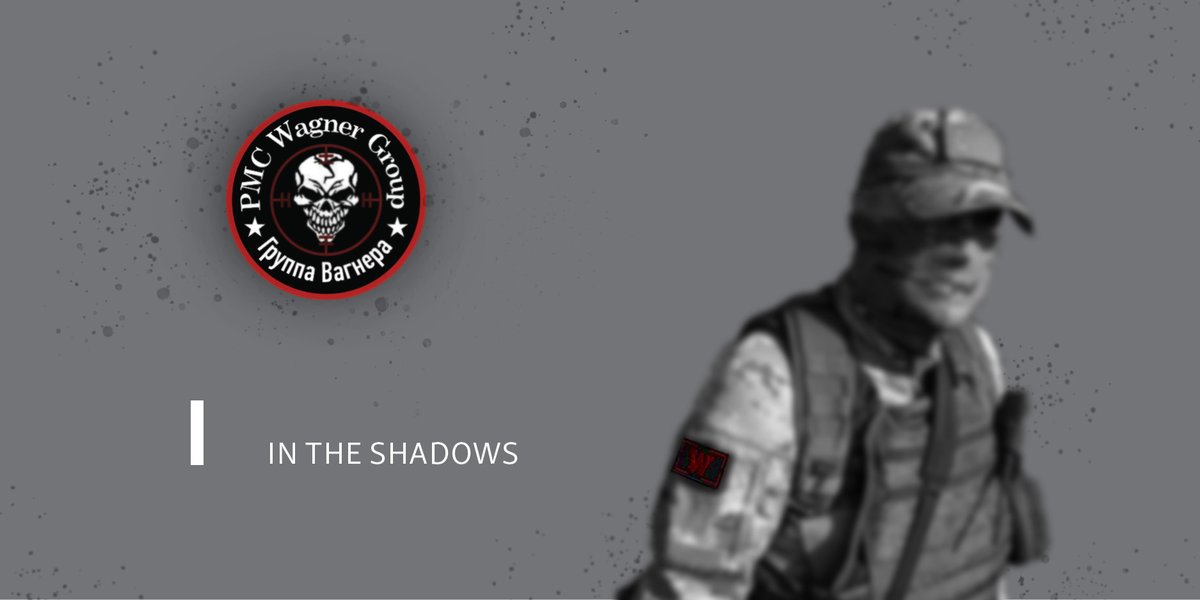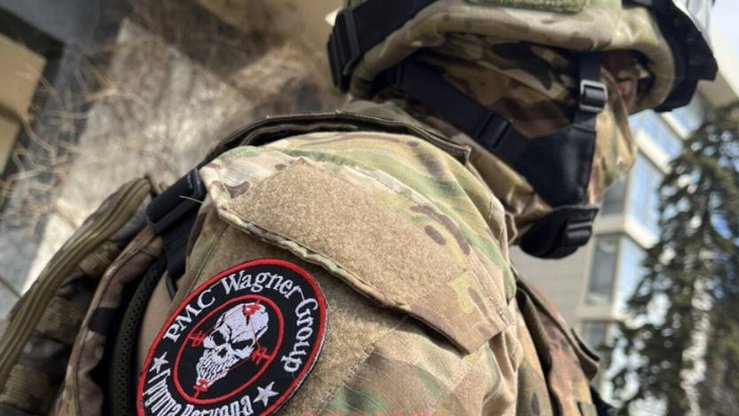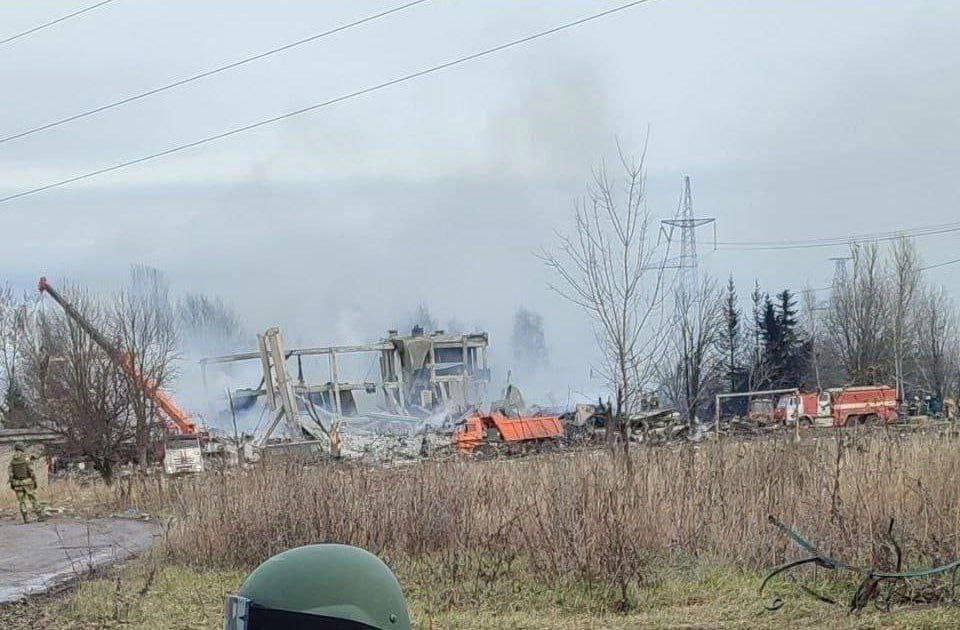Wagner is engaged on multiple fronts, but its battlefield worth is in question—most recently in a seemingly unending & futile attempt at capturing #Bakhmut. But why would a famed outfit struggle so much?
A new look at #WagnerPMC
#UkraineRussianWar
#Mercenaries
🔞
1 of 48
A new look at #WagnerPMC
#UkraineRussianWar
#Mercenaries
🔞
1 of 48

Studies on #Wagner, a unofficial quasi-state military apparatus, illustrate #Kremlin shadow efforts aimed at enabling foreign policy objectives.
Simply, Wagner brings to bear the levers of organized violence where (official) #Russian forces cannot.
2|
Simply, Wagner brings to bear the levers of organized violence where (official) #Russian forces cannot.
2|
This violence is an enabling force, but also a restrictive one. It is, in effect, Wagner's primary capability.
All other internal efforts (media, power-projection, political maneuvering) are oriented towards enabling and maintaining this capability.
russianpmcs.csis.org
3|
All other internal efforts (media, power-projection, political maneuvering) are oriented towards enabling and maintaining this capability.
russianpmcs.csis.org
3|
Crucially, despite Wagner's (now) high-profile nature it "does not officially exist" lending to its ability to prioritize means typically out-of-reach or out-of-bounds by official actors.
q/s: csis.org/analysis/putin…
4|
q/s: csis.org/analysis/putin…
4|

An over-reliance on violence suggests an organization that is inherently fragmented, is present-focused, and beholden to the "glue" of power-by-personality. It also suggests a reliance on national myths to both remain relevant, and tie it to external state strategies.
5|
5|
To understand Wagner as an organization, we need to wind back the clock & step away from the din created by its role in #Ukraine.
(Present) Wagner is, in essence, a brain child of Yevgeny #Prigozhin, a figure emblematic of an upper-authoritarian bulwark of the Russian State.
6|
(Present) Wagner is, in essence, a brain child of Yevgeny #Prigozhin, a figure emblematic of an upper-authoritarian bulwark of the Russian State.
6|

His involvement—early on denied but now acknowledged—is crucial to Wagner's organizational structure. Not because of who he is specifically, but because of what structure he is part of and upholds, and that which informs Wagner's means of operating.
7|
7|
The history of Wagner is (understandably) murky, albeit the focus of investigative efforts. @bellingcat outlines in great detail the inception of Wagner, evolution of Prigozhin's involvement, and their rise to relevancy as a foreign policy apparatus.
8|
bellingcat.com/news/uk-and-eu…
8|
bellingcat.com/news/uk-and-eu…
Prigozhin is by all accounts an oligarch, power-broker, and cult-of-personality. He is innately tied to the Kremlin and member to the #Siloviki.
His role within power structures of Russian leadership place Wagner directly in view of decision-makers.
9|
His role within power structures of Russian leadership place Wagner directly in view of decision-makers.
9|
What matters here is Prigozhin's, and by extension Wagner's, predominance within an increasingly tension-filled leadership cabal, combined with presumably more desperate conditions faced by the Russian military itself.
10|
puck.news/putins-chef-th…
10|
puck.news/putins-chef-th…
However, this does not necessarily mean he 'commands' the actions of Wagner.
Why?
Partly, this is because of the organizational framework in which he is part of.
IOW: He 'reflects' Wagner as an organization at the highest level, but he does not control it.
11|
Why?
Partly, this is because of the organizational framework in which he is part of.
IOW: He 'reflects' Wagner as an organization at the highest level, but he does not control it.
11|
So who controls Wagner? In theory, no one.
There is no absolute hierarchy within Wagner by which power flows based on structural governance. It is propelled by power accumulated within 'roles' whereby each role acts independent, and power exercised maintains the group.
13|
There is no absolute hierarchy within Wagner by which power flows based on structural governance. It is propelled by power accumulated within 'roles' whereby each role acts independent, and power exercised maintains the group.
13|

This sounds contradictory, and that is true if assigning a different paradigm—for example: rule by an authoritarian government with an expansive central bureaucracy (Soviet Union). In the case of Wagner PMC, we need to introduce a new one.
Here are two premises to hold:
14|
Here are two premises to hold:
14|
First, all organizations are composed of beings that build on, and derive from one another, their aims, means, and motivations.
Second, all organizations are a living reflection of present worldviews.
15|
Second, all organizations are a living reflection of present worldviews.
15|
Wagner PMC is a unique expression of these two premises.
Specifically, it can be understood as a disaggregated body of individuals and defined by characteristics of what is known as a 'RED Organization'.
(Integral Theory, K. Wilber; Organizational Paradigms, F. Laloux).
16|
Specifically, it can be understood as a disaggregated body of individuals and defined by characteristics of what is known as a 'RED Organization'.
(Integral Theory, K. Wilber; Organizational Paradigms, F. Laloux).
16|

(RED) are among the oldest of organizational frameworks, dating to humanity's "early conquering armies" and exist to this day "in the form of street gangs and mafias."
"Present versions adopt features of modernity like information warfare."
F. Laloux (2014)
17|
"Present versions adopt features of modernity like information warfare."
F. Laloux (2014)
17|
(RED) have no absolute hierarchies.
Rather, they are upheld by reinforced separation among roles, whereby each role (and by extension each member) advances individual & group influence via simple mechanisms of power: incentives, manipulation, violence, and 'othering'.
18|
Rather, they are upheld by reinforced separation among roles, whereby each role (and by extension each member) advances individual & group influence via simple mechanisms of power: incentives, manipulation, violence, and 'othering'.
18|

These simple mechanisms are key to Wagner's perceived success and power projection (but are equally limiting).
Further, they are endorsed (not sanctioned, owing to its unofficial status) by roles with most power, yet highest degree of separation (Prigozhin, #Putin, etc.).
19|
Further, they are endorsed (not sanctioned, owing to its unofficial status) by roles with most power, yet highest degree of separation (Prigozhin, #Putin, etc.).
19|
Incentives
Wanger recruits are offered higher-than-average wages for participation. These incentives are made explicit and offer a 'better path' than their professionally-trained peers in the armed forces, with the added promise of veteran status for recruits.
20|
Wanger recruits are offered higher-than-average wages for participation. These incentives are made explicit and offer a 'better path' than their professionally-trained peers in the armed forces, with the added promise of veteran status for recruits.
20|
https://twitter.com/leventkemaI/status/1578050656442671108
Manipulation
Recruitment from prisons is key element of manipulation, pulling from the 'bottom' of society—those who are already 'othered' through the legal process—to draw in members who will never attain any real power, and are expendable based on their societal status.
21|
Recruitment from prisons is key element of manipulation, pulling from the 'bottom' of society—those who are already 'othered' through the legal process—to draw in members who will never attain any real power, and are expendable based on their societal status.
21|
https://twitter.com/ChrisO_wiki/status/1587378543322873856
Violence
There is ample evidence of Wagner executing deserters and non-conformists, recently brought back into public view by the death-by-sledgehammer of Yevgeny Nuzhin. The violence extends to include likely war crimes committed by its members.
s: t.me/orchestra_w/32…
22|
There is ample evidence of Wagner executing deserters and non-conformists, recently brought back into public view by the death-by-sledgehammer of Yevgeny Nuzhin. The violence extends to include likely war crimes committed by its members.
s: t.me/orchestra_w/32…
22|

'Othering'
Sexual violence is another brutal but effective simple power mechanism, made apparent by Prigozhin's 'cock divisions' where those 'othered' by Russian society can be effectively and totally manipulated into the least-desirable (thus least powerful) roles.
23|
Sexual violence is another brutal but effective simple power mechanism, made apparent by Prigozhin's 'cock divisions' where those 'othered' by Russian society can be effectively and totally manipulated into the least-desirable (thus least powerful) roles.
23|
https://twitter.com/ChrisO_wiki/status/1599360352403087360
All these mechanisms are based on a necessity to maintain casual relationships, but which never evolve to interpersonal ones.
For example, #Wagner does not employ notions of 'morality' not because it does not have them (rampant use of violence implies it doesn't) ...
24|
For example, #Wagner does not employ notions of 'morality' not because it does not have them (rampant use of violence implies it doesn't) ...
24|
Instead, it does not *require* morals to function. Introducing morality would actually destabilize the organization, undoing the basic premise that its 'glue' is the "continuous exercising of power in [all] relationships."
F. Laloux (2014)
25|
F. Laloux (2014)
25|
Wagner communications are an instrument designed to weave these mechanisms into more complex expressions of otherwise simple concepts.
It relies on simple tropes, displays of glory and honor, and recurring themes of Russian national myth and anxieties.
26|
It relies on simple tropes, displays of glory and honor, and recurring themes of Russian national myth and anxieties.
26|
Communications have evolved to cover and legitimatize Wagner's exploits, elevating them into key roles as saviors or shapers of Russian national destiny.
s: t.me/wagner_comix/22
27|
s: t.me/wagner_comix/22
27|

It targets audiences who are easily manipulated or reactive (predominately male, young, and disaffected) with media tailored to generating intrigue and outrage, and tapping into generational themes and subcultures.
Those subcultures vary greatly in reach and origin.
28|
Those subcultures vary greatly in reach and origin.
28|
https://twitter.com/osint_east/status/1579609080389578763
Figures are stylized, as are combat operations. Identities of 'heroes' are exaggerated, as are those who are subjugated. The expanse and effectiveness of these efforts are broadly known.
The more sophisticated productions combine all the above.
s: t.me/grey_zone/15142
29|
The more sophisticated productions combine all the above.
s: t.me/grey_zone/15142
29|
Symbols of action, notably the sledgehammer, are integrated as symbols of power and retribution. Mundane tools become overt displays of group prowess and influence (including to other organizations) even if power is short-lived.
s: multiple
30|
s: multiple
30|

A metaphor used to describe RED organizations is a "Wolfpack" wherein alpha leaders prevail so long as unquestioned, and chaos is embraced. Subgroups of Wagner PMC literally use this term in often describing themselves.
s: t.me/wolfpack_train…
31|
s: t.me/wolfpack_train…
31|
So what does this organizaiton look like? Where are the boundaries drawn, the mechanisms enforced, and the power accumulated? And what can it actually accomplish?
33|
33|
An aggregation of the elements introduced in this thread so far result in this conceptual version of Wagner's organizational (RED) structure.
Note: it is shaped to minimally resemble a hierarchy, but critical defining elements, like stratified roles, are absent.
34|
Note: it is shaped to minimally resemble a hierarchy, but critical defining elements, like stratified roles, are absent.
34|

It's also important to understand a (RED) organization's relationship to time. They cannot effectively extend power beyond the limits of mechanisms that propel it.
They are present-focused, highly-reactive, and poor at planning, thus mostly incapable of strategic outlook.
35|
They are present-focused, highly-reactive, and poor at planning, thus mostly incapable of strategic outlook.
35|

Returning to the original observation: why is Wagner failing in and around Bakhmut?
The answer may be painfully simple: it is simply not 'organized' well enough to accomplish the complex effort it has set out to do.
36|
The answer may be painfully simple: it is simply not 'organized' well enough to accomplish the complex effort it has set out to do.
36|

In comparison, Ukrainian forces are mounting a considerable defense—albeit also taking heavy losses—not just because of tactical and geographic advantages.
It is because they are a more coherent organization than Wagner (existing at a higher level in the paradigm).
37|
It is because they are a more coherent organization than Wagner (existing at a higher level in the paradigm).
37|
Very simply: the AFU in #Bakhmut may be considered as (AMBER), an organization driven by strong(er) moral principles, high(er) levels of self-awareness, distributed decision-making through stratified roles, and able to project actions further in time (strategic).
38|
38|

Wagner organizational principles leave it with few options for success: either psychological degradation of #Ukrainian forces by amplifying chaos, or simply overwhelming the AFU in numbers via the use of 'expendable groups'.
39|
39|
It is doing precisely the latter, made further infamous by accepting the notion that many convicts, soldiers, and 'others' are sent there simply to feed the grinder (though claims of mass human wave attacks are dubious).
s: t.me/buhanochka_z/37
40|
s: t.me/buhanochka_z/37
40|

Wagner's worldview is built upon Russian national myth: a nation beholden to an unending "geographic destiny" exhibited by its need to expand & conquer neighboring regions to address deep-seated insecurities, and upheld by the ruggedness of its people.
R. D. Kaplan (2012)
42|
R. D. Kaplan (2012)
42|
In spite of how Wagner's power is demonstrated—for example the opening of Wagner centers in cities across Russia—each new member introduced will be thrust into the organization's fragile paradigm, and the history of chaos that comes with it.
43|
43|
https://twitter.com/NeilPHauer/status/1181193593794502656
This is also perhaps why Wagner operates with success in regions where similar organizational structures exist.
The DRC, Mali, Syria—unstable nations or authoritarian governments with environs that Wagner can easily 'plug into' and with effect.
s: t.me/warjournaltg/8…
44|
The DRC, Mali, Syria—unstable nations or authoritarian governments with environs that Wagner can easily 'plug into' and with effect.
s: t.me/warjournaltg/8…
44|

Wagner evolution is depends on its ability to adapt. Internal competition may arise as other Russian PMC increase in power and influence, perhaps by taking advantage of loss-of-power by a depleted Wagner in Ukraine. A changing foreign policy will also inform its relevance.
45|
45|
For all these reasons Wagner is, and will remain, a potent yet fragile force within Ukraine and beyond. For now, the ideological basis for its operating holds, even if that too is under threat from a weakened Russia.
46|
46|
But if under continuing pressure the social glue begins to dry and crack, and if the chaos in Ukraine subsides, it will have to look elsewhere to remain legitimate, or else it will quickly collapse under the weight of the very things that support its existence.
47|
47|

Thanks to @ChrisO_wiki , @NeilPHauer , @leventkemaI , @TheStudyofWar , @juliaioffe , @meduza_en & @RALee85 for threads, translations, and investigations.
Symbols & media adopted from Wagner channels as noted.
You can retweet 'sections' (I, II ...) as well as the 1st tweet.
END
Symbols & media adopted from Wagner channels as noted.
You can retweet 'sections' (I, II ...) as well as the 1st tweet.
END
(+)
Thread will be posted to substack as an expanded version in two weeks, with corrections and amendments made as needed, and with updates to graphics.
Future threads follow this process since my threads are...long.
Unspooled:
typefully.com/osint_east/C5Q…
Thread will be posted to substack as an expanded version in two weeks, with corrections and amendments made as needed, and with updates to graphics.
Future threads follow this process since my threads are...long.
Unspooled:
typefully.com/osint_east/C5Q…
• • •
Missing some Tweet in this thread? You can try to
force a refresh

















